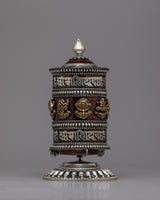
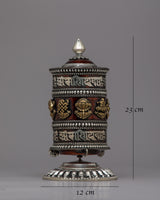
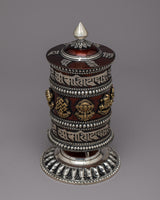
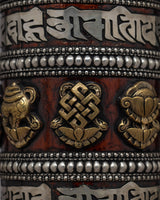

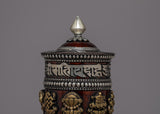
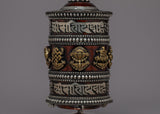
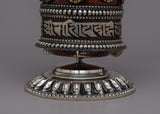
Traditional Prayer Wheel | Handcrafted for Spiritual Practices

100% AUTHENTIC

HANDMADE

FREE SHIPPING
Traditional Prayer Wheel – Copper Body, Brass Stand, and Intricate Asthamangala Carved
About our Prayer Wheel:
Our beautifully designed Prayer Wheel will elevate your spiritual practice. With its elaborate Asthamangala carvings and solid brass support, this prayer wheel adds a touch of spiritual artistry to your rituals. It has a durable copper body. This piece, which weighs 1.044 kg and measures 23 cm in height by 12 cm in breadth, is intended to serve as both a utilitarian and decorative element.
The intricate Asthamangala carvings on this prayer wheel have great spiritual importance since they reflect the eight fortunate emblems of Buddhism. This prayer wheel reflects the union of history and craftsmanship and is perfect for use in meditation or as a striking decorative feature. With this exquisite and significant addition, elevate your sacred space and allow its presence to uplift and enrich your spiritual journey.
Introduction to Prayer Wheel:
A prayer wheel is a cylindrical wheel on a spindle used in Tibetan Buddhism. It is typically inscribed with the mantra "Om Mani Padme Hum" and rotated by hand as a form of spiritual practice and to accumulate merit. Spinning the wheel is believed to have the same spiritual benefits as verbally reciting the mantra. The use of prayer wheels is widespread in Tibetan Buddhism and has spread to other cultures.
--------------------------------------------
Size: 23 cm(Height) x 12 cm(width)
Weight: 1.044 kg
Material: Copper Body, Brass Stand
--------------------------------------------
How does the Buddhist Prayer Wheel benefit us?
The benefits associated with rotating the wheel are numerous. It promotes knowledge, compassion, and bodhicitta in the practitioner and improves siddhis (spiritual powers such as clairvoyance, precognition, etc.). The practitioner can repeat the mantra as often as possible while the wheel is rolling, maintaining a calm, meditative attitude. A Tibetan Buddhist tradition holds that at the completion of a practice session, one should dedicate any acquired merits to the benefit of all sentient beings. Then three times Om Ah Hum. This is usually among Tibetans after finishing any Buddhist practice, including the prayer wheel exercise.


















